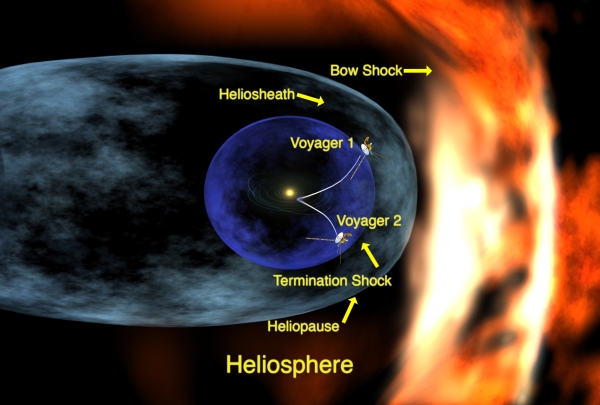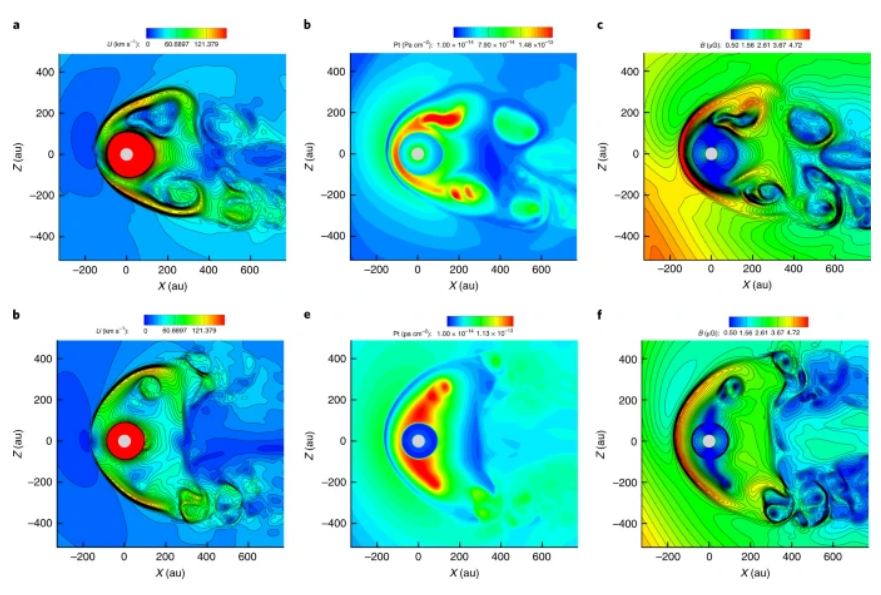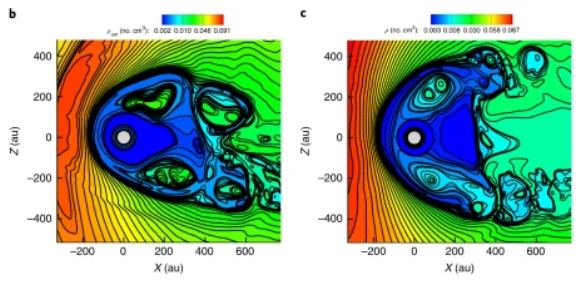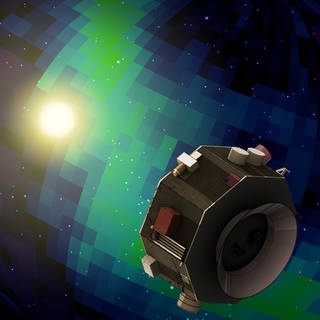At first glance, it looks like something from an alien autopsy. A strange organ cut from a xenomorph's thorax, under the flickering lights of an operating room in a top secret government facility, with venous tendrils dangling down to the floor, dripping viscous slime. (X-Com anyone?)
But no, it's just our Solar System.
This strangely fascinating shape is actually a graphic representation of what our Solar System looks like, or rather the magnetic bubble that surrounds our Solar System. It's a representation of the heliosphere, a massive bubble carved into space by the Sun's constant outflow.
They're calling it the "deflated croissant" model.
The problem with measuring the heliosphere accurately is that we're inside it. Its edge is over 16 billion km (10 billion miles) away. It's only thanks to the pair of Voyager spacecraft that we have any data at all from outside the heliosphere. Voyager 1 left the helisphere behind and entered interstellar space in August 2012, and Voyager 2 did the same in November 2019.

There are missions dedicated to studying the heliosphere, like NASA's IBEX, or Interstellar Boundary Explorer. There are complex interactions where the heliosphere meets interstellar space, a region called the heliopause. IBEX studies what are called energetic neutral atoms. They're created when cosmic rays from outside our Solar System meet charged particles from inside our Solar System. Since these energetic neutral atoms are created through interactions with the interstellar medium (ISM), they serve as a kind of proxy for measuring the edge of the heliosphere.
But the data from those interactions is complex. It has to be fed into computer models to come up with any sensible predictions about the nature and shape of the heliosphere. NASA and the NSF have funded an effort to make sense of it, called the SHIELD Drive Science Center, at Boston University.
A study published earlier this year presents some of the new results on the heliosphere. It's title is " A small and round heliosphere suggested by magnetohydrodynamic modelling of pick-up ions." The lead author is Merav Opher, professor of astronomy at Boston University. The study is published in the journal Nature Astronomy.
Scientists used to think that the heliosphere was shaped kind of like a comet. As our Solar System moves through space, the outflow from the Sun meets the ISM and creates a bow shock or bow wave on the leading edge, and a heliotail on the trailing edge, reminiscent of a comet's tail.
"The shape of the heliosphere has been explored in the past six decades," the authors explain in their paper. "There was a consensus, since the pioneering work of Baranov and Malama, that the heliosphere shape is comet-like."

But this new research is showing us a different heliosphere. More recent evidence, the authors point out, shows that the heliosphere contains two jet-like structures.
Along with data from IBEX, the researchers used data from Cassini and New Horizons in their new study. They're both planetary missions, but they still contributed data on the Solar System. In Cassini's case, it measured particles that are bouncing back towards the inner Solar System from interactions with the ISM. "Cassini's observations of energetic neutral atoms further suggest that the heliosphere has no tail," they explain.
New Horizons measure what are called pick-up ions (PUIs). PUIs are a critical part of this study. They're created as the Sun moves through the partly ionized medium. They exchange charges with the solar wind, and that creates a population of hot pick-up ions (PUIs), which are a different temperature than the solar wind ions.
When Voyager 2 crossed the boundary into interstellar space, it showed that the pressure at the heliosheath is dominated by these PUIs. But at that time, how the PUIs shaped the heliosphere was not investigated. That's what this study has done, and that's how we got this strange new image of our heliosphere.

In the paper the authors explain that "The new model reproduces both the properties of the PUIs, based on the New Horizons observations, and the solar wind ions, based on the Voyager 2 spacecraft observations as well as the solar-like magnetic field data outside the heliosphere at Voyager 1 and Voyager 2."
The PUIs are much hotter than other particles in the solar wind, and that difference is a key to this work.
"There are two fluids mixed together. You have one component that is very cold and one component that is much hotter, the pick-up ions," said lead author Opher in a press release. "If you have some cold fluid and hot fluid, and you put them in space, they won't mix - they will evolve mostly separately. What we did was separate these two components of the solar wind and model the resulting 3D shape of the heliosphere."

Instead of a nice, tidy sort of shape, we get this. Rather than a stretched out, spherical shape with a tail, we have a sort of deflated croissant shape. A bulbous, organic looking shape that looks like some kind of organ.
"Because the pick-up ions dominate the thermodynamics, everything is very spherical. But because they leave the system very quickly beyond the termination shock, the whole heliosphere deflates," said Opher.
While this new image of the heliosphere is interesting purely in graphic terms, it's also important scientifically. That's because of the important role the heliosphere plays.

Outside the heliosphere, cosmic rays are created by energetic events in other Solar Systems. Cosmic rays are high-energy protons and atomic nuclei that move through space at relativistic speeds. Things like supernovae create them, and they travel outward in all directions.
Cosmic rays are dangerous, and the heliosphere is our shield against them. The heliosphere absorbs about 75% of the cosmic rays heading our way, but the ones that get through can be very disruptive. On Earth, we're mostly protected from cosmic rays by our magnetosphere and our atmosphere. But for satellites, spacecraft, and astronauts, the danger is real.
Not only do cosmic rays damage electronics, but exposure to them increases cancer risk for astronauts. And they're such high energy particles that it's difficult to shield astronauts from them. Cosmic rays are one of the main hazards to long-duration space flights, due to the increased cancer risk.

There's also some evidence that increases in cosmic rays as the Solar System moves relative to the galactic plane have led to extinctions in the past. Some researchers also believe that supernovae explosions in the past exposed the Earth to much higher levels of cosmic rays, perhaps triggering the extinction of marine megafauna in the Pliocene. But a lot of that research is controversial.
A better understanding of our own heliosphere might help us understand exoplanet habitability, too. Cosmic ray radiation can render planets uninhabitable, even ones we find in the "Goldilocks Zone" around distant stars. As we gain a better understanding of the shape and function of our own heliosphere, we can apply that knowledge to other solar systems, giving us a more sophisticated way to look at habitability and life.
As it stands now, we don't know enough about our own heliosphere, including its shape, to characterize other heliospheres that accurately.
But an upcoming NASA mission should help. It's called IMAP, or Interstellar Mapping and Acceleration Probe. IMAP is scheduled for launch in 2024, and it'll map the particles streaming back towards Earth from the heliosphere's boundaries.

The DRIVE Science Center will play a role in IMAP's mission. Opher and his colleagues at DRIVE are creating a testable model of the heliosphere in time for IMAP's deployment in 2024. Their model will contain more detailed predictions of the heliosphere's shape and other properties. Scientists can then use IMAP's observations to test them.
"Future remote-sensing and in-situ measurements will be able to test the reality of a rounder heliosphere," the authors write in the conclusion to their paper. "... future missions such as the Interstellar Mapping and Acceleration Probe will return ENA (Energetic Neutral Atoms, what PUIs become after charge exchange) maps at higher energies than present missions and so will be able to explore ENAs coming from deep into the heliospheric tail. Thus, further exploration of the global structure of the heliosphere will be forthcoming and will put our model to the test."